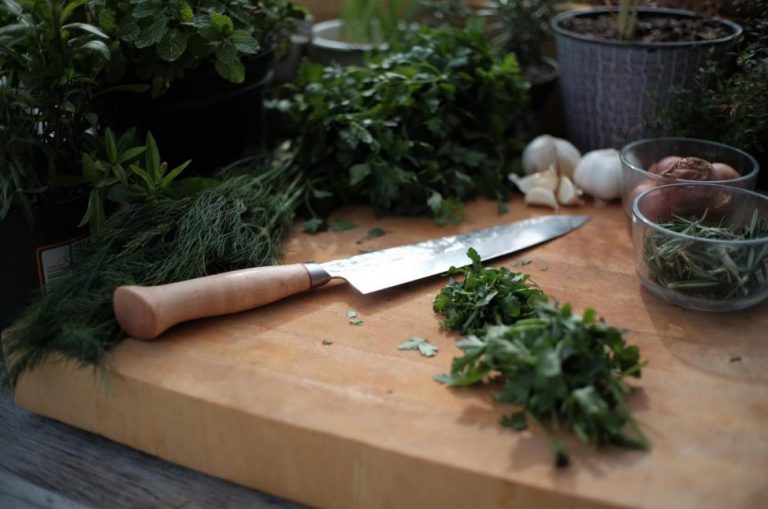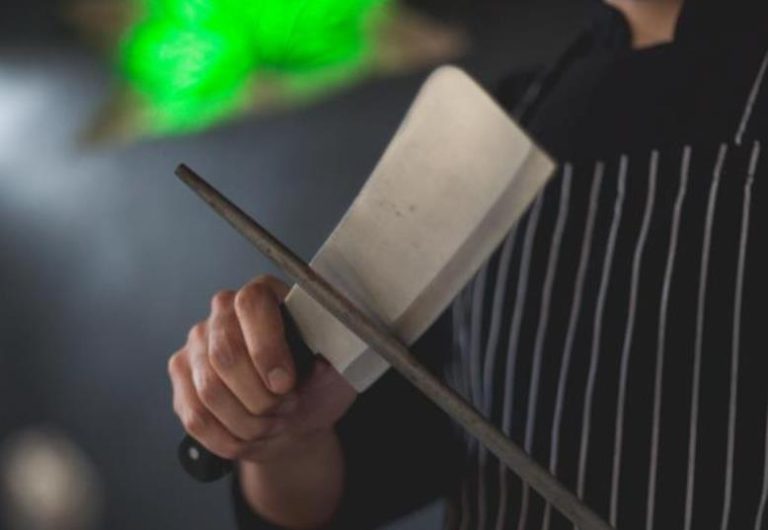The global cheese market is forecasted to reach USD 161.23 billion by 2028. The increase in the market size means more opportunities for cheese knife sellers to capitalize on.
But as the demand increases for cheese-cutting tools, so does the confusion for dealers buying in bulk about what is trending and what is not.
Hence, we have put together this complete cheese knife guide to help you make an informed decision.
What are cheese knives?
Cheese knives are specialized cutlery designed for cutting, shaving, and serving different types of cheese. Each type features a uniquely shaped blade for specific types of cheese, including hard, soft, semi-soft, and crumbly cheeses.
Cheese knives are different from the usual kitchen knives. They have unique blades that help cheese enthusiasts put their cooking artistry to use to get perfectly-cut cheese slices at home.
Why do you need a cheese knife?
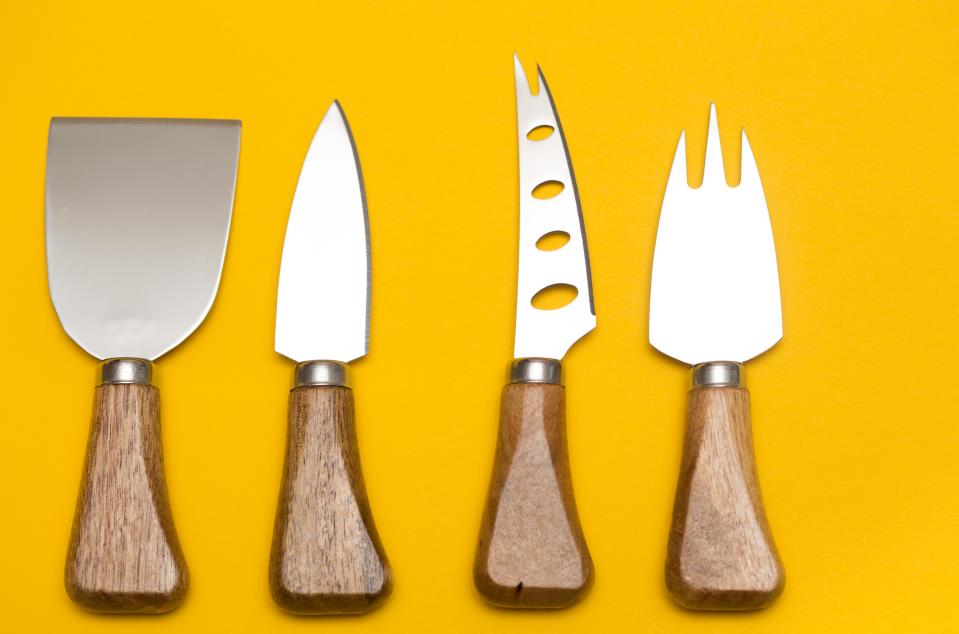
People who love cheese know their cheese-eating experience is complete with the right cheese knife. Different cheeses have different textures, such as soft and creamy, crumbly, or hard and dense, and each type requires a specific knife to achieve the desired cut result.
For example, a soft cheese knife has holes in the blade to stop the cheese from sticking to the surface of the knife. Similarly, a spreader is used only for spreading cream cheese evenly and cannot be used to cut aged cheese into smaller pieces.
Using the appropriate cheese knife ensures that the cheese is cut and served to precision and enjoyed to the fullest. Thus, when buying knives, businesses should choose designs with the most demand and never compromise on quality.
Buy Wholesale Knives and Start Scaling up with Us Today
Contact us and connect with a sales rep to get a free quote.
10 types of cheese knives explained
A typical cheese knife is made from a stainless-steel blade and a wooden or plastic handle for easy grip. Before you stock up on cheese knives, you need to know the different types and their features and uses.
Here are some of the most commonly used types of cheese knives.
Soft cheese knife
The soft cheese knife, also known as the open work blade knife, features a broad blade with holes and a sharp edge that is ideal for cutting soft and semi-soft cheeses. The holes in the knife keep the soft cheeses from sticking, making it labor-saving to slice through them.
The blade is often serrated to avoid crushing the cheese and its soft, delicate texture. Additionally, some soft cheese knives come with a forked tip, making it easier to pick and serve pieces of cheese to guests.
The handle of a soft cheese knife is usually made of materials that provide a comfortable grip, such as wood or plastic.
Best for: Camembert, Brie, and Fresh Mozzarella cheese
Hard cheese knife
The hard cheese knife is one of the longest cheese knives. It has a sharp edge and handles on both ends, allowing an even distribution of pressure when cutting through a block of cheese. It is ideal for cutting through hard, aged cheeses or an entire block to cut into smaller portions.
The sharp and straight edge of the blade makes it easy to slice through the dense texture of hard cheeses, resulting in neat, uniform pieces. The blade’s length makes it easy to cut through large blocks of cheese.
Its handle is typically made from wood or plastic and provides a comfortable grip, allowing for a safe and controlled cutting experience.
Best for: Extra mature cheddar, Comte, Asiago, and Provolone cheese
Cheese spreader

Like a spatula, the cheese spreader has a flat surface with round edges and a dull blade that allows you to evenly spread cream cheese or soft cheese on a slice of bread or a cracker.
Cheese spreaders are incredibly versatile and can also spread condiments like jam or peanut butter. Unlike other types of cheese knives, cheese spreaders have a unique design that makes them perfect for spreading and not cutting.
Best for: Robiola, Cream cheese, and Stracchino cheese
Pronged cheese knife
A pronged fork-cum-knife is a multipurpose tool. It features a tip curled upwards into a spear-like shape, allowing you to cut soft to semi-hard cheeses and then prick them.
The fork-like tip also allows for a secure hold on the cheese, making it easy to transfer to a plate or platter. Additionally, the prongs on the tip can also be used to spear accompaniments, like crackers or fruit, making it a versatile tool for serving cheese.
Best for: Parmesan and Brie cheese
Flat cheese knife
A flat cheese knife is paddle-like and typically has a long, flat blade with a rounded or pointed tip and a broad base, making it easy to cut and serve cheese accurately. The handle of a flat cheese knife is usually made of wood or plastic, resulting in a comfortable grip.
The flat blade allows easy cutting through the cheese, resulting in neat, uniform pieces. The rounded or pointed tip makes it easy to serve the cheese. Moreover, the flat blade of a cheese knife can also be used to smooth the surface of soft cheeses, like Brie, after they have been cut.
Best for: Provolone, Gruyere, Asiago and Swiss cheese
Cheddar cheese knife
Did you know there was a special knife for cutting cheddar cheese? Call it a mini cleaver, semi-hard cheddar knife, cheddar cleaver, or simple cheddar knife; the purpose remains the same.
It is designed with a wide rectangular blade, a long sharp edge, and an ergonomic handle, giving you a comfortable grip over the knife while pushing through semi-hard to hard cheese for clean slices.
This type of cheese knife is especially useful for serving aged cheddar, as it helps to prevent the cheese from breaking or crumbling. Additionally, the sharp point of the blade can also be used to pick up and serve the cheese, making it a versatile tool for serving cheddar cheese.
Best for: Cheddar, Fontina, Gruyere and Colby cheese
Parmesan knife
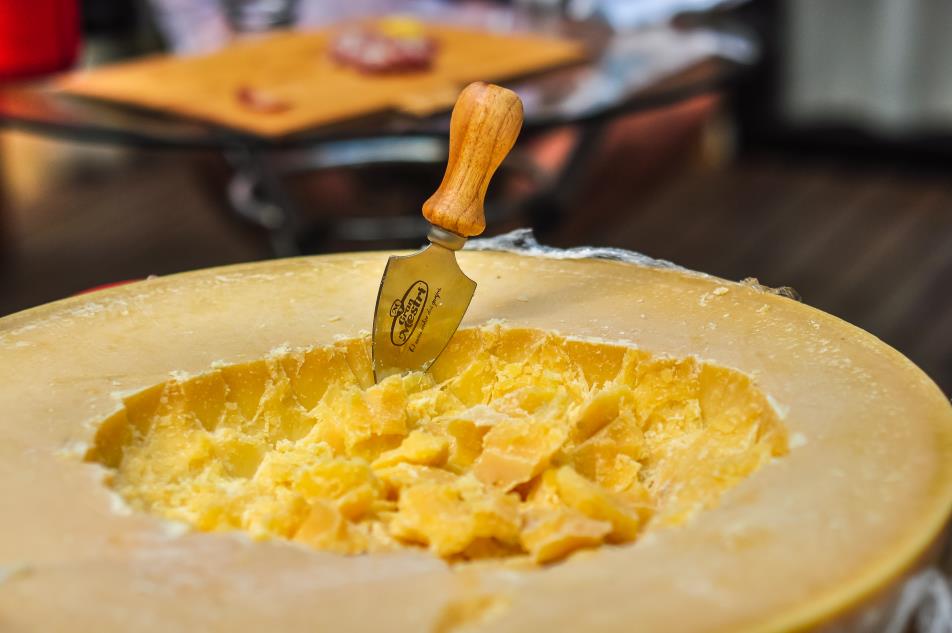
A parmesan cheese knife features a stubby triangular blade with a sharp-pointed tip and a long sharp edge to cut the rinds.
The parmesan knife has 2 types:
- Bell cheese knife: It has a short, stubby, and strong arrowhead-shaped blade that easily cuts through rinds of hard cheese blocks.
- Compact cheese knife: It has a blade that looks like a shark’s tooth and is sharp enough to go through rinds of cheeses that are old and stiff, otherwise difficult to cut.
Best for: Grana Padano, Parmesan and Castelmagno cheese
Gorgonzola knife
The gorgonzola cheese knife features a flat, curved blade with one sharp edge. The short, curved blade allows for precise cuts through the creamy texture of the cheese, while the sharp point makes it easy to pick up and serve the cheese.
This type of cheese knife is especially useful for serving Gorgonzola, as it helps prevent the cheese from becoming mashed or smeared.
A Gorgonzola knife is a must-have tool for anyone who loves to entertain and serve soft, crumbly cheeses like Gorgonzola. Its unique design and functionality make it a great addition to any cheese board.
And who knows, having a Gorgonzola knife in your arsenal may just make you the “blue cheese boss” at your next gathering!
Best for: Blue and Gorgonzola cheese
Slim blade knife
A skim blade knife is designed with a narrow, thin blade, sharp edge, and raided handle. While the small surface area prevents soft cheese from sticking, the raided handle keeps your knuckles away from the board while giving you cleanly sliced portions.
The long, narrow blade allows for precise cuts, making it ideal for slicing through soft cheeses like brie or camembert and harder cheeses like cheddar or gouda. With a tool as versatile as this, you’ll be cutting through cheese like a boss in no time.
Best for: Camembert and Boursault cheese
Narrow plane knife
Like a flat cheese knife, the narrow plane knife typically has a long, narrow blade with a flat surface, making it easy to cut through the delicate texture of the cheese without crushing it.
This type of cheese knife is effective when serving cheeses with strong flavors, as it helps preserve the cheese’s texture and flavor.
Best for: Jarlsberg, Gouda and Cheddar cheese
Buy Wholesale Knives and Start Scaling up with Us Today
Contact us and connect with a sales rep to get a free quote.
Other useful tools for preparing cheese
In addition to cheese knives, some other labor-saving tools like cheese grinder and cheese plane are effective when preparing cheese. By adding these items to the product catalog, businesses can target a wider audience which can help them increase their sales and gain a competitive edge.
Below, we discuss the features and uses of some of the most useful cheese-preparing tools that promise to take the cheese-preparation experience to another level.
Cheese plane
Cutting thin slices from blocks of aged cheese can be a struggle. You need to have the right tool and be precise in your measurements for every piece to be cut equally in thickness. And this is where the role of a cheese plane comes in.
A cheese plane is a tool for slicing or shaving cheese. It typically has a long, flat blade that is sharpened on one edge to make thin, even slices of cheese while keeping your hand at a distance from the board.
Cheese rind cutter
A cheese rind cutter removes the rind or outer layer of hard cheese. A cheese rind cutter typically consists of a pointed downward tip with a sharp edge that pierces through the hard rind to crack it open when pushed into the block of cheese.
Some cheese rind cutters are made with multiple blades to allow for a clean, even cut, while others have a curved blade that allows for easy removal of the rind.
This is an ideal tool to cut through huge blocks of Parmigiano and Reggiano without damaging the soft, edible part in the middle.
Cheese grater
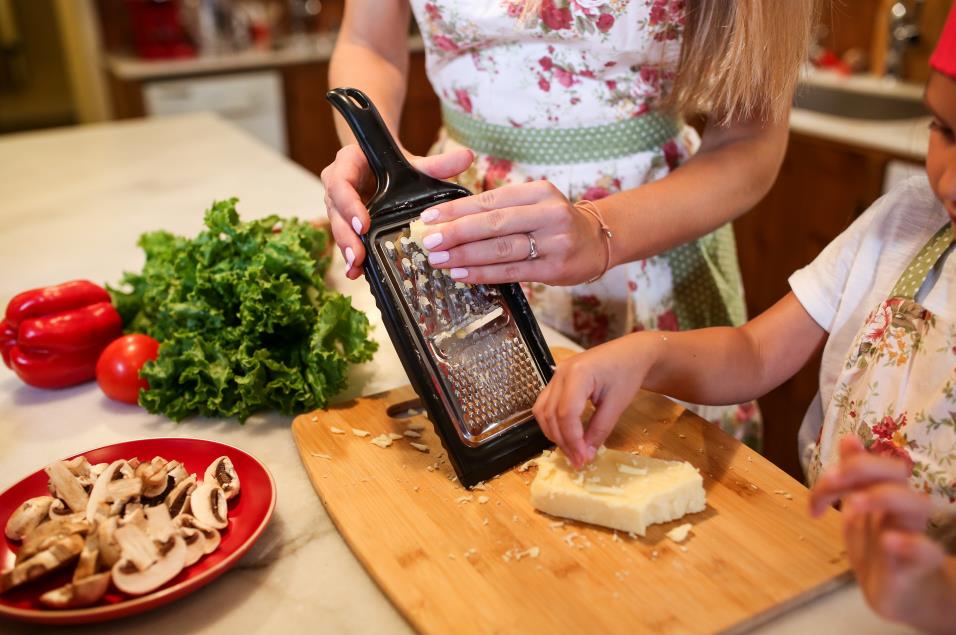
Cheese graters are made from stainless steel and are commonly found in every household. There are different types of graters, such as:
- box grater,
- rotary grater,
- flat grater, and
- rasp grater.
These tools, irrespective of their type, have sharp, jagged blades attached to the surface. The cheese is rubbed against the blades to create thin, shred-like pieces that can be used in cooking or as a topping for dishes like pasta or salads.
Moreover, some cheese graters have adjustable blades that allow you to change the shred size from having more fine ones to thicker ones.
They can be used for all types of cheese, from soft, semi-soft, hard, and semi-hard cheeses, letting you enjoy the shavings on your favorite meal.
Cheese wire
Cheese wire, also known as bow wire, is used for cutting soft cheese. It features a wide metal handle that lets you conveniently cut through soft cheeses without spreading or spoiling them.
The cheese wire is inserted into the cheese and then pulled through it, creating clean, even slices. This is especially useful for cheeses like Brie or Camembert, which tend to crumble or fall apart when cut with a knife.
Moreover, cheese wires come in various thicknesses and lengths, depending on their intended purpose and the cheese types they are made for.
Cheese Fork
Typically made of durable stainless steel, cheese forks feature two sharp prongs that make it easy to handle cheese slices precisely.
While these can simply be placed on a cheese board or platter for serving, they are also frequently used for slicing cheese blocks by holding them in place as you slice through it with a cheese knife.
Investing in quality cheese-cutting tools is a smart choice, and purchasing from a trusted source will ensure that these tools will last for years to come.
What to consider when buying wholesale cheese knives
When buying wholesale cheese knives for your business, there are several key factors to consider. From material to blade design and brand reputation, choosing the right cheese knife can make all the difference in enhancing the cheese-eating experience.
Let’s explore what to look for when buying wholesale cheese knives so that you can make an informed purchase and stock your shelves with the best tools for the job.
Handle design and material
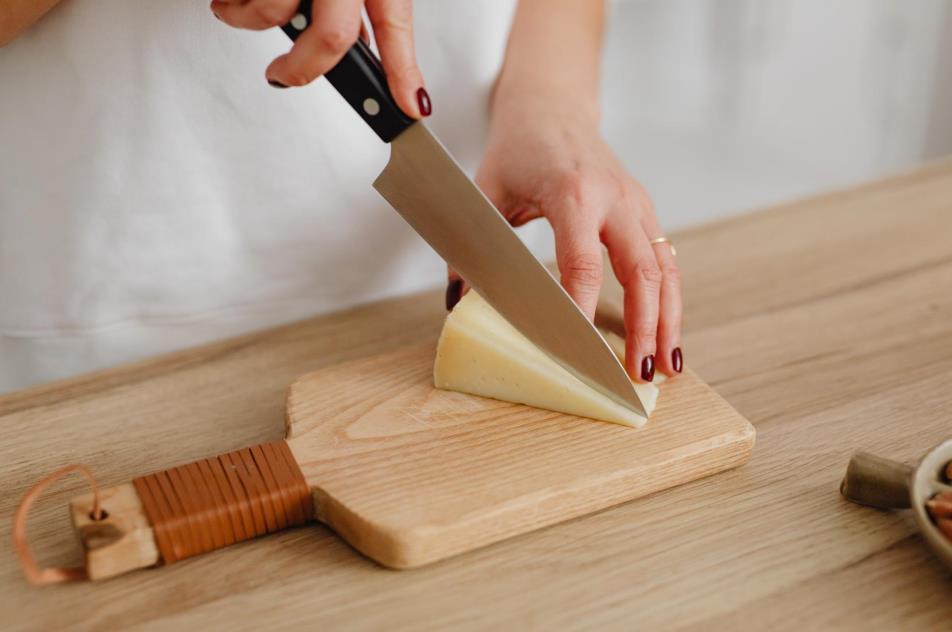
The handle of the cheese knife should provide a comfortable and secure grip. Consider the size and shape of the handle and the material used to determine if it is comfortable and will provide a labor-saving cheese-cutting experience for your customers.
Wood is often a popular choice for handles because of its natural feel and warmth. Plastic and silicone handles are lightweight and easy to clean, while stainless steel handles can provide a sleek and modern look but may become slippery when wet.
Additionally, the size and shape of the handle should be ergonomically designed for easy and comfortable use. A handle that is too small or too large may be difficult to grip, leading to discomfort during use.
A well-designed handle should also be balanced with the blade, making it easier to control the knife when slicing cheese, thus giving the customers a great experience.
Brand reputation
Consider the reputation of the brand when buying wholesale cheese knives. Look for brands with a history of producing high-quality, durable, and well-designed products so you know you are dealing with the best in the business.
Leeknives has been providing state-of-the-art wholesale knives to its customers since 1993. If you want to purchase in bulk, get in touch, and we will respond promptly.
Price
Wholesale cheese knives can range in price, so consider your budget and the expected return on investment when purchasing. It’s important that businesses find a balance between purchasing high-quality knives that will satisfy their customers and keeping costs low to maximize their profit margins.
When considering the price, take note of the following:
- Your target market: Are you selling to budget-conscious customers or those willing to pay more for high-end products?
- Brand reputation: Are you purchasing from a well-known or lesser-known brand?
- Volume discounts: Can you negotiate a better price by purchasing in bulk?
By taking these factors into account, you can make an informed decision about what price range is right for your business and your customers.
Should you sell cheese knives?
There are several reasons why selling cheese knives can be a good decision for you. First, cheese is a popular food item, and cheese knives are essential for serving cheese properly. According to a report by Mordor Intelligence, the global cheese market is expected to grow at a compound annual growth rate of 3.5% from 2020 to 2025.
Buy Wholesale Knives and Start Scaling up with Us Today
Contact us and connect with a sales rep to get a free quote.
As the demand for cheese continues to grow, the demand for cheese knives is also likely to increase, making it a lucrative business.
Second, cheese knives are used in both commercial and domestic settings, making them appealing to a wide range of customers, which can help businesses reach a larger audience and increase their sales.
Third, cheese knives make for a thoughtful and practical gift for cheese lovers, which can provide businesses with a new source of revenue.
Fourth and finally, by offering cheese knives, businesses can attract new customers and increase foot traffic, as cheese lovers will come to your store specifically to purchase the tool they need.
Conclusion
Cheese knives make a great addition to kitchen accessories. As for businesses looking to expand their product offerings, adding a range of cheese knives and tools can be a great initiative for scaling your business by entering new markets, availing newer opportunities, and serving a larger pool of customers.
Cheese is likely to remain popular over the next few years. The tools and knives needed to prepare them are also likely to surge in demand, resulting in a golden opportunity to build a profitable business. Make your move now!


